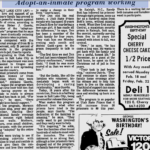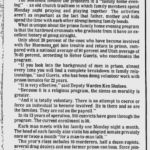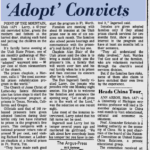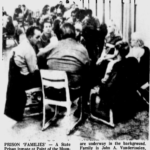Not So Frequently Asked Questions
Learn about the stories behind the words we use on this site and in our work.
Why do you use the typewriter font?
Note: Why We Use the Typewriter Font
At our core, we celebrate the enduring spirit of communication within the prison system. In an era dominated by digital interactions, prison remains a stronghold for the art of letter-writing, both handwritten and typewritten. This tradition is not just a means of keeping in touch; it is a lifeline for many inmates.
Typewriters hold a special place in this environment. They are a rare and valuable asset, often out of reach for prisoners who earn as little as 40 cents per hour. All electronics available for purchase in prisons are clear so that no contraband can be hidden inside. A typewriter like this will cost a prisoner about $250. In many facilities, typewriters are not even available for purchase. Those who do manage to obtain one often become pivotal figures within their communities, much like the first telephone owners. They serve as hubs of information, assisting fellow inmates with legal documentation, correspondence, and maintaining connections with the outside world.
Our use of the typewriter font pays homage to these resilient communicators. It symbolizes the importance of every letter written and every word typed within the confines of prison walls. It is a nod to the struggle and the perseverance of those who continue to reach out and connect, despite the barriers they face.
Why the name 'Adopt An Inmate?'
Melissa: The definition of the word adopt is ”to take (someone or something) by choice into a relationship.” That’s it. I vividly remember the call from county jail when Rick said to me, “There are a lot of good people in here. And a lot of sad stories. I want to do something to help them.” That was the seed of the organization. Several years later, with Rick still in prison, we had both discovered What Really Matters.
In the decade that we have been doing this work, we have received a small number of comments from people who … don’t love the name. All but one from people outside of prison. It sounds like a legal transaction and that’s too much responsibility. It sounds condescending. It sounds too nice – why would anyone want to do that? We adopt children, highways, and pets. I don’t know if it’s fair to put incarcerated folks in that same category. It might push those involved to think that in some way they are better than inmates.
Rick: I came up with the organization name in 2013 while I was still fighting my case in county jail.
It was something like a year or so after I had suggested this name to Melissa, and a couple of months after I arrived in prison that she found some articles about this amazing pastor’s work. Missy and I both thought that keeping this name might in some way honor the work of those people in Utah. So for me, there is a bit of sentiment and nostalgia associated with the name “Adopt an Inmate.”
That word ‘adopt,’ to me, indicates a willingness to take on more responsibility than just mere friendship or acquaintance. And that’s what we’re trying to imply and encourage. The biggest shock to me when arriving in county jail after my arrest, was that the people inside were often what any person would consider ‘good.’ They provided comfort and help to other inmates. They provided comfort and help to me. It was a shock because I always assumed that everyone in prison or jail deserved to be there and that they were there because they were a danger to others. I knew that innocent people had gone to jail, but most of the people inside had to be of the sort that I would not relate to. I believed myself to be ‘better’ before I ended up thrown in with them.
Consider somebody who travels to China or India to adopt a child there. Are the potential parents of that child doing so because they think they are better than that child, or because they believe that they have something of value they can offer that child and want them to have a chance to grow up without the potential developmental problems associated with orphans?
And that epiphany for me, is what led me to believe that if we could get people to start a dialogue with somebody on the inside, they would also have the same sort of ‘aha’ moment that I had. ‘Oh, duh, these are human beings.’ My sister and I agreed that we were not wanting people merely to write letters but to take on the responsibility of being another source of support for an inmate, and sometimes, in the case where an inmate had no family at all, their only support. An unexpected lifeline.
So, in my opinion, I believe that a person who adopts an inmate will have the opposite experience. He or she will come to the same conclusion I did: “I have been thinking about incarceration and the incarcerated in a distorted, unrealistic way.”
In some ways, people on the outside are literally “better” than inmates, but not as human beings. They’re better off. They’re free, and they have free time and maybe even money that they can provide for the person they’re connecting with. I have never met anyone in prison who had problems with somebody ‘adopting’ them or with the name of our organization. That doesn’t mean that nobody would have a problem with it, but we now have over 15k inmates who’ve applied with only a single person who complained about the name, and that person, after complaining, printed out dozens of adoption forms at his own expense and handed them out to his fellow inmates.
I think that a name is important, but a name is never going to satisfy everyone. It will be offensive to somebody if you just wait long enough. It’s not terribly productive in my opinion to worry too much about it. We should convey what we mean and handle the objections as they come, if they come.
Remember the prisoners as if chained with them—those who are mistreated—since you yourselves are in the body also. – Hebrews 13:3 (NKJV)
What Do We Call Our Adoptees?
The language used to describe people who are incarcerated is often a topic of debate. Terms like Prisoner, Inmate, Felon, Convict, and Incarcerated Individual each carry different connotations and reactions. At Adopt an Inmate, we choose to refer to them simply as people. This reflects our belief in their humanity and dignity, regardless of their circumstances.
However, there are times when it is necessary to indicate that a person is currently in custody. For such occasions, Rick coined the term PIP, which stands for person (or people) in prison. This acronym is a nod to one of Rick’s favorite books, Great Expectations by Charles Dickens. The protagonist and narrator of the book is Philip Pirrip, affectionately known as Pip.
Articles about the subject
- I Am Not Your ‘Inmate’ in The Marshall Project by Lawrence Bartley
- Words Matter: Using Humanizing Language by The Fortune Society
- Abstract: The Language of Incarceration by Alexandra Cox in Sage Journals
Why do you use the bee 🐝 theme for volunteers?
Bee is derived from the Old English bēn meaning “a prayer, a favor.” It was first coined in the late 18th century, referring to “a meeting of neighbors to unite their labors for the benefit of one of their number” — just like little worker bees in a hive. (Bonus: Melissa means honeybee in Greek.)
The earliest known example in print is a spinning bee, in 1769. Other early occurrences are husking bee (1816), apple bee (1827), and logging bee (1836).
Farmers, artisans, and neighbors came together for barn raisings, husking bees, and quilting parties, pooling their skills and resources to accomplish tasks that were beyond the capacity of a single household
These gatherings were a testament to the power of community bonding and the necessity of shared labor in a time of limited resources and geographic mobility. They fostered a unique labor dynamic, where individuals contributed their skills and talents to create something beautiful together, strengthening community bonds and promoting social evolution.
| Task | Historical Context | Social Context |
| Quilting Bee | Nineteenth-century gatherings for collaborative quilt-making | Women’s sphere of influence, fostering community and skill-sharing |
| Logging Bee | Communal efforts to fell trees and prepare timber | Men’s domain, emphasizing physical strength and cooperation |
| Spinning Bee | Collaborative events for spinning yarn or thread | Both men and women participated, contributing to textile production |
It is with intention that we honor and continue the tradition of communal labor, fostering community, providing learning opportunities, skill-sharing, camaraderie, and *the transformative power of collective effort. Credit to Sewing Trip.
*See a video here, of a group of female worker Bees 🐝 rushed to the aid of a single bee to free her from after being trapped in a spiderweb.
Melissa's She-EO Title
I was looking for a title that didn’t sound like every other title, but instead something friendly and approachable.
I stumbled on an article about Seth Goldman, the Co-Founder and CEO of Honest Tea, who used the title Tea-EO (now Tea-EO Emeritus). As it turns out, Seth is not the only one.
During my annual girls weekend with my besties in 2014, (the year after Rick was arrested), I asked for them to help me come up with a title similar to Seth’s. Because my girl’s weekend name is “She who skins deer,” (a story for another time), one of them said “She-EO,” and I knew that was it.
Like the name of our organization, there have been a few people, again exclusively on the outside who … don’t love it. And I get it.
Here’s the thing. Our work can be overwhelmingly dark and depressing, especially for empaths – which most of our volunteers are. We have had some who decide to stop working for us because reading letters from people who are serving life sentences, or are on death row, or have spent decades in solitary confinement, some who are likely innocent – is too much to bear. Part of our mission is to uplift and empower people on the inside.
The good news is, people in prison … love it. And I work for them. They feel comfortable reaching out directly to someone they normally wouldn’t. When I answer a call from prison there is often someone on the other end saying, with a smile in their voice, “Is this the She-EO?” They never forget that title and use it every time they call or write.
I love it.
Why is Melissa’s newsletter column titled “Hey, Boo?”
Inspired by a touching scene in the movie, To Kill A Mockingbird, those two words, ‘Hey, Boo,’ come at the moment in the movie when Scout (Mary Badham) coaxes the frightened neighborhood recluse Boo Radley (Robert Duvall) from the shadows. That moment, even more than the racial context of the story, conveys the essence of Lee’s simple story: The open-hearted encounter of people we find odd or frightening. Our work at AI can be summed up in that same way.
Boo is also the name of this little imp, who likes to help in the office. You can find a picture of her (and her boss Scout) in each issue after Fall 2016.






